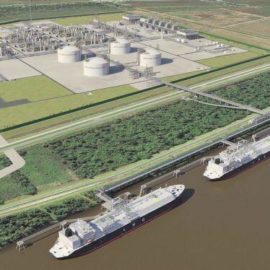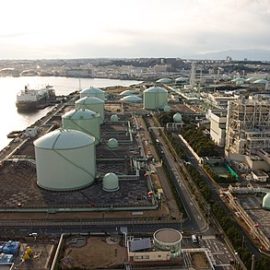Don’t approve this plant as it will cause more flooding damage.
Several environmental groups are suing Louisiana over its three-year-old decision to allow a 630-acre liquefied natural gas plant to move forward in Plaquemines Parish without a key coastal permit. The groups fear the plant’s current site leaves it highly susceptible to flooding from hurricanes, which could lead to pollution in surrounding areas. Conversely, officials have touted LNG projects as a boon for the state and local economy. In August 2019, Louisiana’s Department of Natural Resources determined that Venture Global LNG – a natural gas export company headquartered in Virginia – didn’t need a coastal use permit to construct a new $13.2 billion export plant called Plaquemines LNG. Currently under construction, the plant will span nearly a square mile of land about 20 miles south of New Orleans near the Myrtle Grove community – an area that was flooded during Hurricane Ida for weeks. If completed, the LNG plant would export up to 20 million metric tonnes of natural gas per year by ship to other countries. It’s also expected to create 250 local jobs. The plant is among more than a dozen LNG export terminals proposed in Louisiana, which has made the state at the epicenter of the fossil fuel industry’s push to increase natural gas exports across the globe.
wwno.org
The group used new computer modelling to make their case.
In August, the three environmental groups – the Deep South Center for Environmental Justice, the Sierra Club and Healthy Gulf – petitioned the Department of Natural Resources to reconsider its decision, citing new computer modeling about the area’s storm surge risk. When the state first exempted Plaquemines LNG from a coastal use permit in 2019, it cited the planned storm protection levee as one of the reasons, according to the lawsuit. In 2020, the rationale was amended to state that the site was located at least five feet above sea level and wouldn’t have a significant impact on coastal waters. The modeling – completed after Ida’s submerged the site – suggested that had the plant already been built, the 26-foot-high levees planned by the company might have been overtopped by the Category 4 storm’s surge, according to the group’s lawsuit. The surge might have peaked about foot higher at 27 feet when combined with wave height. A private research firm, Atmospheric and Environmental Research, crafted the modeling using satellite technology, according to the lawsuit. Had the storm taken a different track, the groups said the maximum water height could have reached 37 feet – 11 feet higher than the planned levees. The lawsuit also noted that the National Oceanic and Atmospheric Administration estimates that sea levels will rise another 1.5 to 2 feet off Louisiana’s coast by 2050 – the project’s minimum life span.
Toxic chemicals could be released in a flood.
If flooded, the groups argued that the waters could carry toxic chemicals used by the heavy industry off site into neighboring waters and communities. In an affidavit, Dr. Ivor van Heerdan, the former deputy director of LSU’s Hurricane Center, echoed those concerns, stating the site would likely be flooded “in the not-too-distant future” by storm surge from a major hurricane. “There would, therefore, be a high probability of runoff of landfill (during construction) and chemicals (during operation) being carried off the site and into homes, businesses, farmland, and fragile coastal wetlands,” he wrote in an expert opinion requested by the Sierra Club. In late October, the Department of Natural Resources Secretary Thomas Harris rejected the groups’ petition, stating it came too late. “This is essentially an out of time appeal of OCM’s (the Office of Coastal Management’s) determination, and I do not find that conditions have changed sufficiently for me to reopen this matter,” he said in an Oct. 24 letter.
The agencies action is what energized this opposition.
The agency’s denial spurred the group’s lawsuit, calling for a judge at the Baton Rouge court to review the state’s decision. In the lawsuit, the groups ask the judge to vacate the state’s denial of their petition, declare that the project requires a coastal use permit, issue a cease and desist order on construction and remand the issue back to the state department. On Thursday, Department of Natural Resources Communications Director Patrick Courreges said, “DNR believes our staff acted in accordance with the applicable state law and regulatory guidance, but beyond that cannot comment on pending litigation.” Plaquemines LNG is one of four plants that Venture Global wants to build. Two others are underway in southwest Louisiana. When operations begin, each facility has the potential to emit several million tons of greenhouse gasses per year – a key contributor to climate change – in coastal areas that are increasingly vulnerable to rising seas and more intense hurricanes.
I know they want to be close to the Gulf but that puts then in flooding areas.



